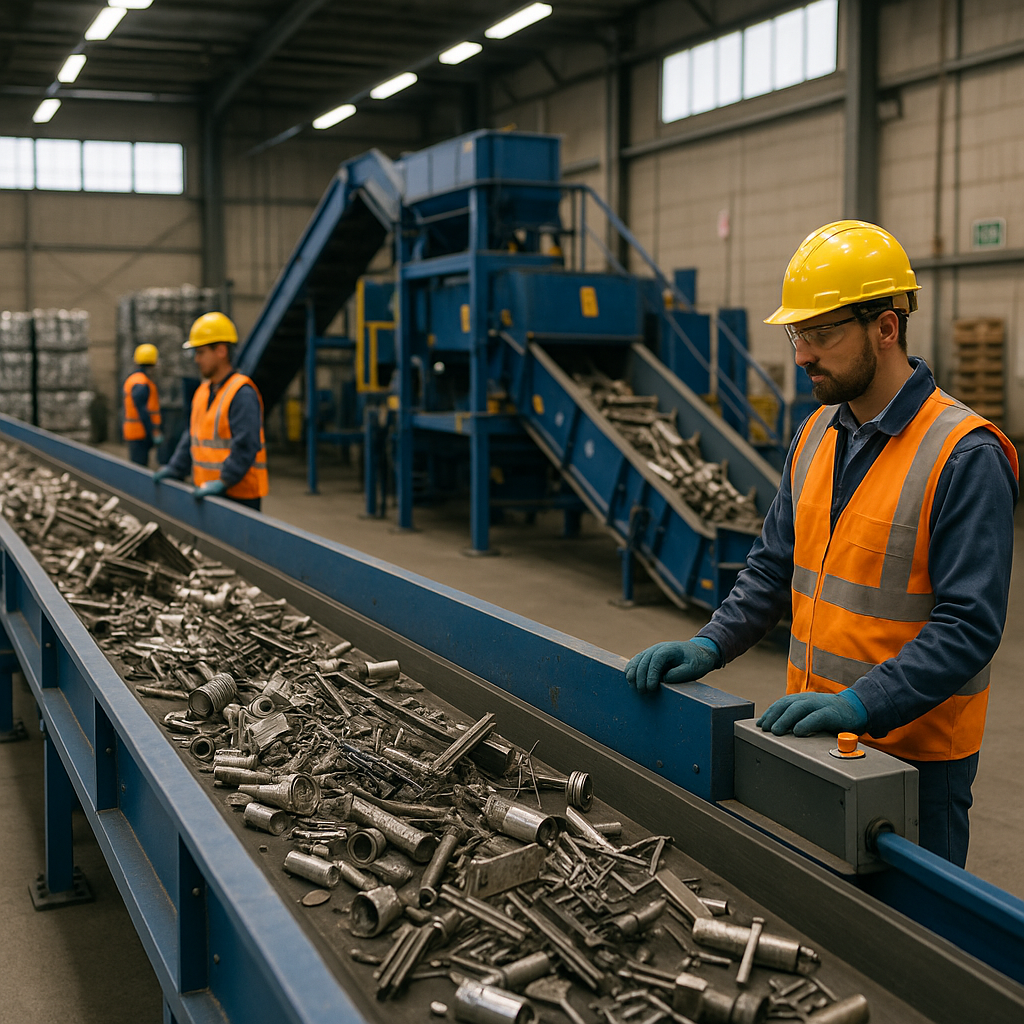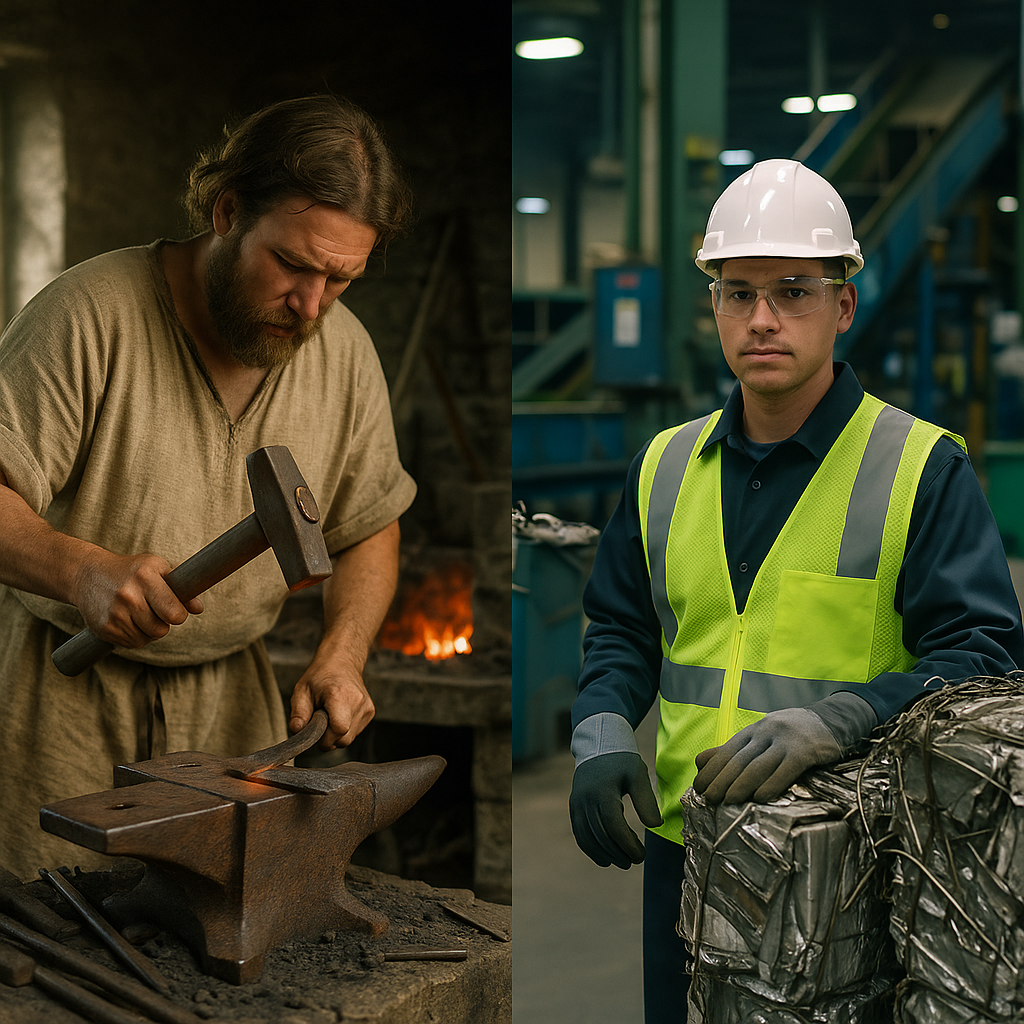5901 Botham Jean Blvd, Dallas, TX 75215
What Is the History of Recycling Metal?
May 13, 2025Did you know metal recycling dates back over 2,500 years? Archaeological evidence shows humans have been repurposing metals since at least 400-500 BC, making it one of humanity’s oldest sustainability practices. This longevity demonstrates our ancestors’ practical understanding of metal’s inherent value.
Metal recycling reflects human innovation at its finest. Throughout history, societies faced with resource limitations turned to recycling as a solution. Archaeological studies of ancient waste dumps reveal that during periods of scarcity, there was significantly less discarded material. Records from as early as Plato’s time in 400 BC document organized recycling activities.
From Roman-era Pompeii to medieval Europe, metal recycling has been a consistent practice throughout human civilization. Historical evidence shows recycling efforts intensified during times of war and famine. Before the Industrial Revolution, scrap metals like bronze were routinely collected throughout Europe to be melted down and reused. This early circular economy approach shows that metal recycling isn’t just a modern environmental movement, but a time-tested resource management strategy.
How did ancient civilizations recycle metal?
Ancient civilizations practiced sophisticated metal recycling long before modern sustainability became a concern. Egyptians, Romans, and Greeks all engaged in methodical metal reuse during the Bronze Age (3300-1200 BCE). These efforts were driven by the practical need to conserve valuable resources rather than environmental concerns.
Remelting was the primary technique for recycling metals. Artisans would heat discarded or damaged metal objects to their melting points, allowing the material to be reshaped into new tools, weapons, or decorative items. This practice was particularly common with bronze, a copper-tin alloy crucial for technological advancement in ancient societies.
The Romans demonstrated remarkable efficiency in their metal recycling practices. They systematically collected scrap metal from broken tools, weapons, and architectural elements. These materials were then reprocessed in specialized facilities, creating a sustainable cycle of metal use that supported their expanding empire and military needs.
In ancient Egypt, copper chisels used for pyramid construction provide a tangible example of practical recycling. When these tools became blunt after repeated use on hard stone, craftsmen would melt them down and reform them rather than discard them. This process ensured that precious metals remained in circulation within their economy.
Perhaps one of the most impressive examples of ancient metal recycling was the Colossus of Rhodes, one of the Seven Wonders of the Ancient World. This massive bronze statue was constructed using metals recovered from abandoned weapons and military equipment, demonstrating how recycling could be implemented even for monumental projects.
Ancient civilizations also practiced alloying as part of their recycling processes. By combining different recycled metals, they created stronger materials with enhanced properties. This practice conserved resources and drove metallurgical innovation, allowing for the development of superior tools and weapons.
Trade networks facilitated the movement of recycled metals between different regions. This exchange allowed for widespread distribution of valuable metals and encouraged the sharing of recycling techniques between cultures. Communities with access to recycling knowledge gained economic advantages through resource efficiency.
These early recycling practices reveal an impressive understanding of material value and resource management. Ancient civilizations recognized that metals represented significant investments of labor and resources, making their conservation through recycling a logical economic choice.
Environmental considerations, while not the primary motivation, were an indirect benefit of ancient metal recycling. By reusing existing metals, these societies reduced the need for mining operations, which often had significant impacts on local ecosystems. This approach to metal usage demonstrates an intuitive form of sustainability that predates modern environmental consciousness.
The techniques developed during this era laid important groundwork for metallurgical practices that would evolve over centuries. Many fundamental principles of metal recycling established in antiquity continue to influence modern approaches to metal recovery and reuse.
| Civilization | Metals Recycled | Techniques | Notable Practices |
|---|---|---|---|
| Egyptians | Gold, Copper | Remelting, Alloying | Recycled copper chisels for pyramid construction |
| Romans | Bronze, Iron | Remelting, Refining | Systematic collection and reprocessing of scrap metal |
| Greeks | Bronze | Remelting | Utilized recycled metals for public works and military applications |
| Mesopotamians | Copper, Bronze | Remelting | Recycled for tools and weapons |
How did metal recycling evolve during the Industrial Revolution?

The Industrial Revolution in the 18th and 19th centuries transformed metal recycling from an informal practice into a structured industry. As factories multiplied across urban landscapes, the demand for metal resources surged to unprecedented levels.
Cities grew rapidly during this period, creating both challenges and opportunities for resource management. Scrap yards emerged as crucial components of the new industrial ecosystem, collecting, sorting, and processing discarded metals for reuse in manufacturing.
Urban recycling became increasingly sophisticated during this era. Metal collectors roamed city streets gathering discarded items to sell to factories, creating an informal but essential supply chain that connected waste generators with manufacturers eager for raw materials.
The technological advances of the period made recycling processes more efficient. New smelting techniques and machinery allowed for faster processing of scrap metal, transforming a necessity-driven practice into a formalized business sector.
While the Industrial Revolution accelerated metal recycling practices, the concept itself wasn’t new. Earlier examples demonstrate the historical value placed on metal reuse. Johann Gutenberg’s printing press, invented in 1436, utilized an innovative alloy of lead, tin, and antimony, allowing printers to melt down and repurpose the type letters regularly, preserving valuable materials.
Blacksmiths were among the most skilled recyclers before and during the Industrial Revolution. They routinely collected metal scraps from damaged farm equipment, tools, and household items, reforging these materials into new products to extend their useful life and conserve resources.
The economic drivers for recycling during this period were significant. Mining was expensive, dangerous, and limited by geographic constraints. Recycling offered a more accessible source of materials for the growing industrial base. Factory owners quickly recognized that reprocessing existing metals was often more cost-effective than extracting new ore.
This era laid the groundwork for our modern recycling infrastructure. The large-scale metal recycling efforts that developed during the Industrial Revolution established practices and systems that continue to evolve today.
| Time Period | Recycling Practices | Motivation |
|---|---|---|
| Pre-Industrial | Reforging metals like bronze, remelting copper chisels, alloying recycled metals | Resource conservation, economic necessity |
| Industrial Revolution | Formal scrap yards, urban recycling systems, smelting advancements | Increased metal demand, cost-effectiveness |
What role did World Wars play in metal recycling?

World Wars I and II elevated metal recycling from a practical activity to a national priority. The intense military demands created an urgent need for metal resources, reshaping societal views on reuse and conservation.
World War II (1939-1945) significantly impacted metal recycling practices. The massive production needs for tanks, ships, aircraft, and artillery led to resource shortages, necessitating innovative solutions. This era saw the launch of the first nationwide campaigns promoting metal recycling in participating countries.
Communities united in displays of patriotism and solidarity. Citizens donated household items like pots, pans, metal toys, and decorative pieces. The collection expanded to include car bumpers, farm equipment, and even historic artifacts like Civil War cannons and iron fences—all melted down to support the war effort.
These wartime scrap drives symbolized national unity. Local communities organized events where people contributed metal items they could spare. Children eagerly gathered scrap, while adults donated larger items, making metal recycling a patriotic duty that transcended social boundaries.
The urgency of wartime needs spurred significant innovations in recycling efficiency. With traditional material sources limited, governments and industries developed new processes to quickly convert scrap into usable materials, laying the groundwork for modern recycling infrastructure.
Beyond practical benefits, wartime recycling campaigns fundamentally changed public perception. What had been seen as practical frugality became a vital contribution to national security. Government propaganda highlighted how recycled materials directly supported troops, creating a strong emotional connection to the process.
Resource shortages during both world wars encouraged conservation practices beyond just metals. As noted, “Massive government promotion campaigns during World War II urged citizens to donate metals and conserve fiber, emphasizing its patriotic importance.”
The legacy of these efforts continues to influence modern recycling. The large-scale collection systems and public education campaigns developed then established patterns that evolved into today’s environmental movement.
| Material | Collection Method | Military Application |
|---|---|---|
| Scrap Metal | Community drives, donations of household items, farm equipment, car parts | Tanks, ships, planes, weapons |
| Rubber | Nationwide drives collecting tires, raincoats, hot water bottles, boots | Not suitable for reuse, spurred synthetic rubber production |
| Paper | Organized by Boy Scouts and schools, Paper Troopers program | Explosives, fabric glue for aircraft wings |
| Aluminum | Community collections | Limited use due to difficulty in processing for aircraft |
How has metal recycling evolved in modern times?

In the late 20th and 21st centuries, metal recycling has transformed significantly. The first Earth Day in 1970 marked a pivotal shift in environmental awareness. Public campaigns gained traction, leading to increased participation in recycling programs.
Today’s recycling landscape is vastly different from its historical forms. Previously driven by economic factors, it has evolved into a sophisticated industry balancing profit with environmental preservation. Modern households routinely separate recyclables, providing a steady stream of materials for processing facilities.
Technological Breakthroughs in Metal Recycling
Advanced sorting technologies have transformed the recycling process. Sensor-based systems using X-ray fluorescence (XRF), X-ray transmission (XRT), and near-infrared (NIR) technologies identify and separate metals with precision. These innovations improve efficiency and the purity of recycled materials.
Automated robotics with artificial intelligence capabilities have transformed sorting operations. These systems rapidly identify and sort different metal types, learning and improving over time. Robotics integration has reduced labor costs while increasing processing speeds.
Drones play a crucial role in scrapyard management. Using light detection and ranging technology (LiDAR), they create detailed 3D models of stockpiles and estimate material volume and weight, optimizing storage and transportation planning.
Environmental Sustainability Drives Innovation
Modern metal recycling offers substantial environmental benefits. Recycling aluminum saves up to 95% of the energy required to produce it from raw bauxite ore, reducing fossil fuel consumption and carbon emissions.
Hydrometallurgical processes have emerged as alternatives to traditional smelting. These water-based chemical methods extract metals at lower temperatures, producing fewer pollutants. Such innovations make recycling viable for a wider range of metals, including rare earth elements.
The industry embraces circular economy principles, emphasizing resource use for as long as possible through better product design and end-of-life recovery systems. Companies increasingly design products with recycling in mind, making disassembly and material recovery more efficient.
Data-Driven Recycling Operations
Software systems have transformed recycling facilities. Data analytics enable companies to track material flows, optimize processing, and make informed decisions. These systems manage everything from inventory to regulatory compliance.
Blockchain technology addresses challenges related to material traceability and authentication. By creating immutable records of transactions, blockchain verifies the origin and composition of recycled metals, building confidence and combating fraud.
Artificial intelligence algorithms analyze market trends, helping recyclers make strategic decisions about buying, selling, and inventory management. By processing vast data, AI identifies patterns that humans might miss, allowing facilities to optimize operations based on predicted demand for specific metals.
Challenges and Future Directions
Despite technological advances, the industry faces ongoing challenges. Contamination remains a significant issue, as mixed materials complicate the recycling process and can lower quality outputs. Public education about proper recycling practices helps address this problem.
Electronic waste presents both opportunities and difficulties. Modern devices contain valuable metals in minute quantities, making recovery economically challenging without specialized equipment. New technologies like pyrolysis and plasma arc melting are being developed to process these complex materials more effectively.
Market fluctuations affect the economic viability of recycling operations. The value of scrap metal can vary significantly based on global demand, potentially disrupting recycling programs. Industry advocates push for stable markets and supportive policies that encourage consistent recycling efforts regardless of temporary price changes.
Conclusion: The Ongoing Legacy of Metal Recycling

Metal recycling bridges historical innovation and future sustainability. From ancient civilizations reusing metals for practical purposes to modern advanced sorting technologies and hydrometallurgical processes, recycling has evolved to meet environmental challenges. This evolution signifies not just technological advancement but a fundamental shift toward resource conservation and environmental stewardship.
Looking ahead, the metal recycling industry continues to embrace circular economy principles through product designs focused on recyclability and innovative tracking systems. These advances promise significant reductions in energy consumption, greenhouse gas emissions, and conservation of natural resources. For your organization’s metal recycling needs and to contribute to this sustainable legacy, contact Okon Recycling at 214-717-4083.
